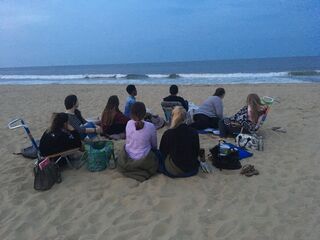Environment
Teaching in Nature: Taking the Classroom Outside
Outside learning boosts focus and reduces stress.
Posted July 29, 2020
Like many parents across the United States, I recently reviewed our school district's plans for the upcoming school year. For us, it’s a mixture of mostly remote learning with a little (optional) in-classroom learning (plus tears, fears, uncertainty, mental health concerns, and a sense of wonderment on how exactly teachers and parents are going to do this). I also am a college professor and my university has been diligently working on its reopening plans as I think how I’m going to adjust my instruction.
The silver lining, for me, is this simple phrase: “Teachers are encouraged to use outdoor spaces—weather permitting.” Yes! This makes me happy!
There are physical, emotional, and psychological benefits for teaching in the natural world. Students show improved cognitive abilities and focus, as well as a greater level of engagement in the educational content and process (Blair, 2010; Chawla, 2015; Li & Sullivan, 2016; Rios & Brewer, 2014). In addition, there is evidence that the natural world can improve creative and critical thinking (Berezowilz, et al., 2015; Williams & Dixon, 2013) especially in K-12 settings (Barnes, Cross & Gresalfi, 2011; Benfield, Rainbold, Bell & Donovan, 2013).
Personally, when I teach in a traditional indoor classroom, I find that phones and computers in front of faces in sterile classrooms equals disengaged students. A few years ago, I started taking my classes outside. The first benefit of teaching outside is that shakes up routines and comfort zones. The second benefit is more obvious, we are learning in nature.
But how do you do it?
Taking your students outdoors might pose some logistical challenges but it's well worth the reward. Depending on your district/institution, the choices might vary. There might already be an outdoor location dedicated to classroom use. If not, you can pick a piece of the lawn or sit underneath a tree.
Some obvious considerations: Be sure the location is not in the middle of a highly trafficked area that may be distracting. Scope out a place that is relatively quiet and comfortable in advance of class. Also, give your students ample time to prepare. You might encourage them to bring a chair and/or a blanket. They may also need a notebook or a charged laptop. Consider class size and topic. Nature’s acoustics are wonderful but need to be taken into account.
If you work in a city or an urban area, you can still find your space, but you might need to be a bit more proactive and creative. I meet regularly with my classes at sites off-campus. This comes with a few accommodations. First, my university requires students to sign an off-campus waiver form, so check with your institution and the legal department to see if off-campus is an option for you. Ask students about accessibility. One semester I had a student with limited mobility. We accommodated her by choosing convenient, accessible locations.
Logistics is another factor to consider. For example, I leave time at the end for those students to get back home or to campus for their next scheduled class. For K-12 teachers, leaving school grounds is likely not an option at all. Is there a corner of the grounds you can make your own? I find that returning to the same outdoor classroom helps students feel connected to that space.
I anticipate that you might ask: Isn’t the outdoors distracting? Yes! But I would argue in good ways. Nature has the added component of its benefits — open spaces, fresh air, vitamin D, and a break from the routine. I always start my classes with a grounding exercise. When I teach at the beach, we dip our toes in the ocean; when I teach on the grass, we take our shoes off.

Depending on the age of your students, you can preempt distraction by discussing the structure. Tell the students that class will start with a fun outdoor activity (try any of Joseph Cornell’s wonderful ideas), then get to the material. Maybe allow the last five minutes for doing cartwheels or moving their bodies.
Teaching outside takes away tech-savvy classrooms. It requires rearranging lesson plans for my outdoor classes. I can still use my slides to support my content delivery, students either bring a charged tablet or laptop or (less environmentally friendly) they may print the slides to bring. More often, we have lengthy discussions. Adapting instruction definitely takes some creativity and outside-the-box thinking, but we are educators, we are good at that. The added benefit is that we are demonstrating to our students inventiveness and adaptability.
Sometimes nature hands you teachable moments (or even just moments of awe) like the deer that often wander into my classrooms. Definitely the bugs, butterflies, and birds, and sometimes the clouds floating by, are distracting. I roll with it and we often get a moment of peace or even a good laugh. Nature is full of metaphors and your students will naturally come up with their own examples.
Does your administration need some convincing about the benefits of teaching in nature? The Children and Nature Network has amazing infographics packed with research findings you can use as evidence. For K-12 folks, a great resource is Green Schoolyards and their initiative to bring learning outside. Watch their webinar from June and join one of their working groups, particularly #11, which is for early adopters—districts interested in trying out some of these strategies. If you are a counselor educator, I wrote a chapter about this topic in my book.
From my own research and observation, I find that teaching outside helps students feel calmer, more centered and engaged. Many students tell me that it’s their favorite time of the week because it’s some of the only time they get outside, off screens, and in nature. Even students who are self-described “indoor people” remark as such. In children, it helps reduce the effects of nature deficit-disorder (Louv, 2005) and improves focus and regulation (Atchley, Strayer & Atchley, 2012). For us, the educators, it gets us in the fresh air surrounded by nature's bounty, helping us feel calm and restored — which we all could use a little of right now.
References
Atchley R., Strayer D., & Atchley P. (2012) Creativity in the wild: Improving creative reasoning through immersion in natural settings. PLoS ONE 7(12): e51474.
Barnes, J., Cross, D., & Gresalfi, M. S. (2011). When does an opportunity become an opportunity? Unpacking classroom practice through the lens of ecological psychology. Educational Studies in Mathematics, 80, 249–267.
Benfield, J. A., Rainbolt, G. N., Bell, P. A., & Donovan, G. H. (2013). Classrooms with nature views: Evidence of differing student perceptions and behaviors. Environment and Behavior, 47, 140–157.
Berezowitz, C. K., Bontrager Yoder, A. B., & Schoeller, D. A. (2015). School gardens enhance academic performance and dietary outcomes in children. Journal of School Health, 85, 508–518.
Blair, D. (2010). The child in the garden: An evaluative review of the benefits of school gardening. Journal of Environmental Education, 40(2), 15–38.
Chawla, L. (2015). Benefits of nature contact for children. Journal of Planning Literature, 30, 309–317.
Li, D., Sullivan, W. C. (2016). Impact of views to school landscapes on recovery from stress and mental fatigue. Landscape and Urban Planning, 148, 149–158.
Louv, R. (2005). Last child in the woods: Saving our children from nature-deficit disorder. Algonquin.
Rios, J. M., & Brewer, J. (2014). Outdoor education and science achievement. Applied Environmental Education and Communication, 13, 234–240.
Williams, D. R., & Dixon, P. S. (2013). Impact of garden-based learning on academic outcomes in schools: Synthesis of research between 1990 and 2010. Review of Educational Research, 83(2), 211-235.




